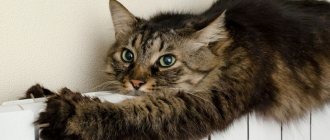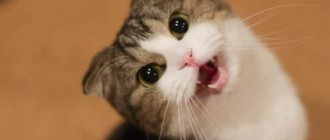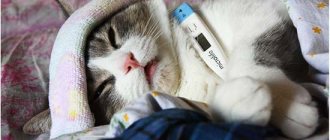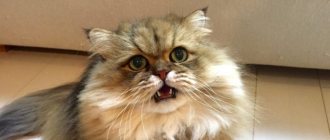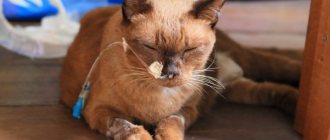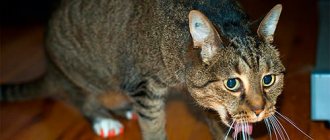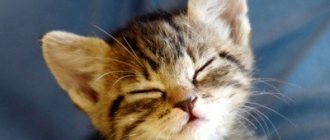When cats can shake
Cats can tremble not only in their sleep, but also while awake. The main problem for the owner is determining the cause of the trembling and whether any disease is present.
If this phenomenon occurs quite often, it is necessary to determine the room temperature. If the room temperature is not comfortable for the pet, measures should be taken to provide warmth to the pet. The measure consists of raising the room temperature or providing the animal with warm bedding and eliminating drafts.
It is necessary to provide cats with warm bedding.
Sign that the cat is freezing
A sign that your pet is freezing can be the “curl” position adopted during sleep and a deeply hidden nose.
The cat hides its nose if it is cold.
Stress
Trembling in a cat's body often accompanies stress.
It is known that pets are unusually emotional. If a cat receives a serious shock, it may begin to tremble.
The cause of stress in your pet can be:
- the appearance of a new animal in the house;
- transporting a cat in a carrier that she did not have time to get used to;
- fight with a dog;
- visit to the veterinary clinic.
Feeling stressed, the pet begins to tremble violently, starting from the tail. To eliminate stress, it is important to show maximum attention to the animal. It is necessary to calm your pet using all available methods.
If trembling due to stress does not go away for a long time, you can seek help from a veterinarian. The specialist will select sedatives.
Sleep epilepsy or sleep disorder
How to distinguish between nocturnal seizures, are seizures a manifestation of epilepsy during sleep or is it a sleep disorder?
Differential diagnosis of paroxysmal events during sleep
To clarify the nature of nocturnal attacks, an objective research method is video EEG polysomnography. An option for diagnosing epilepsy in sleep is video EEG monitoring; studies are more informative after sleep deprivation.
If during a paroxysm epiactivity is simultaneously recorded on the EEG of sleep, then these paroxysms are of epileptic origin, that is, they are epileptic seizures in sleep.
Night attacks can be short and not accompanied by epileptiform EEG discharges; then these disorders of non-epileptic origin are more often classified as parasomnias.
Sleep disorders are often associated with certain stages of sleep and have a characteristic clinical picture.
At an appointment with an epileptologist, there are also options when the patient has nocturnal seizures and epilepsy, but this is not epilepsy.
Let us give a clinical example of seizures during sleep, accompanied by epileptiform activity on the EEG, but not related to epilepsy.
A 3-year-old boy came to see him with nocturnal paroxysms in the form of sleepwalking and sleep-talking. According to my mother: “2 hours after falling asleep, he gets out of bed, says, and walks around the apartment. It's like he's looking for something. More often than not, something is unclear. Some of the words can be understood; they are associated with sleep, with the events of the day. Sometimes the son laughs, cries, moans, is afraid, and is in a hurry. The eyes are open, but the gaze is unconscious or “wild”. After about 10 minutes I manage to calm him down and put him to bed. He falls asleep calmly. After treatment with sedatives, there was a break in his sleepwalking for 4 months, and then gradually became more frequent up to 2-4 times a month.” On the EEG, the patient has epiactivity of the type of benign epileptiform discharges of childhood in a small amount in the background and during sleep. When conducting an EEG with sleep deprivation: during sleep recording, neurophysiologists described a paroxysm (sat down on the bed, did not react, said a few words), but at this moment no epiactivity was noted in the EEG. A diagnosis was made: Parasomnias (sleeping, sleeping). Concomitant diagnosis: Benign epileptiform disorders of childhood. There are currently no data for active epilepsy. Antiepileptic drugs were never prescribed to this patient. Emphasis was placed on the need to maintain a rational daily routine. In therapy, he received sedatives or nootropics in age-related doses in the form of monotherapy (pantothenic acid, adaptol, atarax, phenibut, decoction of sedative herbs, novopassit) in courses of 1-2 months, 1-3 courses per year. The response to such therapy is always good: the parasomnias described above completely stopped for 4-8 months or decreased significantly; could be of an erased nature (sits on the bed in a dream, sits for 3-5 seconds, lies down and sleeps further; no more than 1-2 times a month). The child has been observed by an epileptologist for several years. Over time, complaints about sleep disturbances gradually become less and less. According to the EEG, epiactivity of the DERD type persists: in different recordings it may be in a small index or absent.
A kitten's active sleep is not a reason to worry
Most of the speculation surrounding the concern comes from kitten owners. We dare to assure you that if your cat twitches in his sleep, but he is not yet 12-15 months old, this is normal . Don't worry if the kitten sleeps in an unnatural position or if its eyes are slightly open. The first is explained by the fact that kittens are not so demanding of comfort, the second is due to the presence of a third eyelid, a transparent film that protects the eye during sleep, even if it is open.
The kitten may twitch violently, roll over, and even meow after stress or active play. If the baby is sleeping and you notice that his paws are twitching, it means that the four-legged animal is walking or running in its sleep. Until 1.5–2 years of age, activity in the REM phase is absolutely normal and is explained by an incompletely formed nervous system.
Motor activity during sleep of an adult cat
It is normal for a cat to twitch slightly during sleep once it has passed adolescence. Adaptation of an animal in the outside world and among “its own kind”, strengthening its nervous system, completing the construction of “owner-pet” relationships contributes to its psychological stability. The cat does not experience significant stress and therefore sleeps more peacefully.
In an adult, REM sleep is accompanied by:
- infrequent and not pronounced movements of the paws;
- twitching of the lip, mustache, ears;
- motor activity of the tail;
- rare screams, meows, growls.
If a cat older than two years old experiences emotions characteristic of a kitten in a dream, it is highly likely that it may be diagnosed with behavioral changes - increased nervousness, aggressiveness. It is difficult for such animals to adapt close to humans, and sometimes living together becomes impossible.
Do cats dream?
It was cats, or rather, their dreams, that made it possible to prove to the whole world that animals also plunge into the world of dreams. Moreover, scientists suggest that our pets' dreams are much richer and more dynamic than ours. It all started when doctors began to study the phases of human sleep. To confirm their assumption that healthy people lose the ability to move during REM sleep, an experiment was conducted on a group of cats.
All animals had a small area of the brain removed, which was responsible for muscle atonia in the REM phase of sleep. After the animals were fully rehabilitated, the scientists' suspicions were corrected. The observed cats stood on their paws, walked confidently, and turned their heads, as if watching someone. While in a state of sleep, cats sniffed and turned their ears. The experiment proved that cats see, hear and touch dreams.
This is interesting! A healthy, adult animal does not move during REM sleep, although rapid eye movements and slight twitching are considered normal.
With the development of medical equipment, it was possible to prove that during dreams, cats experience real emotions: fear, joy, excitement, aggression. Near the animals under observation, “pheromones” of a same-sex cat were sprayed and the observed one showed aggression. In the opposite case, when the scent of an animal of the opposite sex was sprayed, the observed behaved calmly or interestedly. That is, animals not paralyzed by the REM phase not only sensed the outside world, but also made natural, instinctive decisions. These observations led to the conclusion that in their dreams, cats see themselves and their surroundings very realistically.
This is interesting! Experiments were carried out on cats, dogs and rodents. Cats surprised scientists by very naturally emitting hunting in their dreams. The dogs unexpectedly hinted at the animal essence, imitating the behavior of wild wolves. The rodents broke all records, because even in their sleep they were able to solve the tasks assigned to them.
The study of human and animal sleep continues. Of course, today it is no longer practiced to remove part of the brain for the sake of observation. To relieve atonia during the REM phase, blockades of part of the brain are used. Modern scientists are on the verge of a big discovery, since the experiments included observations of brain activity using highly sensitive scanners. There is no doubt that cats dream, but perhaps we will soon find out exactly what their dream world looks like. Already today, scientists have managed to find out that kittens see their first dreams while still in the womb.
Why does a person twitch in his sleep?
Experts have identified several types of night twitches, each of which has its own cause and a specific way of manifesting itself.
A fairly common syndrome that causes short-term spasm of a certain muscle group. This occurs due to uncoordinated muscle tone and a state of complete relaxation. When a person falls asleep, the brain perceives this as a possible state of death. Therefore, the body begins to receive impulses so that the brain makes sure that the person is alive.
If the nerve impulse fails to touch the muscles of the body, the brain sends the signal again, only with more powerful force. Having reached its goal, the impulse disrupts the calm and state of relaxation, thereby provoking involuntary twitching.
Sleep paralysis
Becomes active during the transition from the waking state to the stage of falling asleep. Hallucinations, panic, a feeling of fear, and rapid breathing may occur. Particularly susceptible people imagine otherworldly forces or the presence of intruders in the house.
Common causes of paralysis are disturbances in the day and night routine, severe shocks, stress and a sedentary lifestyle.
An equally common cause of nighttime tremors is “Ekbom's restless legs syndrome.” It is characterized by burning and severe pain in the foot and lower leg when falling asleep or during sleep. The result is an involuntary shaking of one or both legs, causing a sudden awakening.
When are there reasons for concern?
The owner should worry, and it is better to immediately consult a doctor if twitching during sleep resembles convulsions . If you have the slightest doubt, wake up your pet and observe how quickly he wakes up. A healthy cat, even if in a completely relaxed state, will fully wake up within 10-15 seconds. If the half-asleep state seems suspicious to you, you observe that the cat has difficulty breathing, raising its head or swallowing saliva - call a doctor.
If you cannot wake up your pet or he loses consciousness, call a doctor immediately, as the seizure is likely to recur. After a severe seizure (depending on its cause), the cat may lose consciousness and never regain consciousness. Seizures are a very serious condition and indicate that the brain is unable to control the central nervous system.
Important! Videos periodically appear on the Internet of how a sleeping cat suddenly jumps up and runs, can crash into obstacles, etc. It may look funny, but this behavior indicates severe disturbances in the functioning of the central nervous system.
A separate risk group is pregnant and recently given birth cats. Immediately after giving birth, when the cat is resting, a seizure may indicate postpartum preeclampsia - a very dangerous condition that will lead to the death of the pet if emergency care is not provided to her. Constant, increasing trembling, turning into convulsions, is a sign of hypoglycemia, which quickly develops into a coma and is fraught with the death of the cat.
A seizure or violent twitching can be explained by a number of events that are not related to illness. After severe stress or fright, moving, a fight, or experiencing danger, a cat is likely to twitch in its sleep - this is not entirely normal, but no special measures need to be taken. Decreased control of the central nervous system indicates that the cat's brain and neural connections are temporarily "mothballed." Everything will return to normal when the pet’s body recovers. If the cat was not stressed and looked healthy all day, you need to rule out:
If you notice that your cat is sleeping restlessly and does not look healthy (faded fur, dehydration, fever, dry mucous membranes), you need to consult a doctor, since only a specialist will be able to “screen out” the necessary diagnosis:
Cats are much less likely than dogs to suffer from epilepsy, but the development of the disease is likely after receiving traumatic brain injuries. Disturbances in the functioning of the central nervous system can also be caused by such non-obvious deviations as a lack of taurine, an imbalance of magnesium, calcium and phosphorus, intoxication from the use of low-quality beds, bowls and means for preventive treatment.
Source
Physiological causes of trembling
Sometimes a cat trembles due to external factors such as a sudden change or decrease in the temperature of the surrounding area. Physiological factors of tremor also include stress, sexual arousal, deep sleep or some reflex processes in the animal’s body.
Cold
You will often notice that your cat will shiver after swimming or spending a long time outside on a cold day. This tremor is a mechanism of thermoregulation and does not allow the animal to freeze for a long period of time.
Pampered domestic cats get chills even with a slight drop in ambient temperature, while a pet hardened by frequent walks can stay outside for a long time, even in severe frosts. Owners should take into account such individual characteristics of their cats’ bodies to determine the duration of the walk, since hypothermia easily leads to the development of colds and inflammatory pathologies.
Important! Even if the room is warm, the animal's fur must be thoroughly dried after bathing. It is also important to ensure there are no drafts and not to allow the cat to lie on a cold surface.
Emotional excitement
The cat may tremble as if it were cold when there is strong emotional arousal, positive or negative. Both during fear and during times of great joy, a large amount of certain hormones enter the animal’s bloodstream, which provoke muscle tremors.
By this sign you can determine the mood of your pet. For example, when nervous, a cat shakes as if frozen, arches its back, hisses or meows loudly. Sometimes the readiness to attack is expressed only in the shaking of the tail raised up. At the same time, sitting on the lap of its beloved owner, the animal may tremble slightly and purr with pleasure.
Sexual arousal
During the period of sexual heat, all the senses of male cats become more acute. In the absence of a sexual partner, animals are constantly nervous, strive to get out of the house, and may show aggression or excessive intrusiveness. The cat is shaking from the powerful release of sex hormones into the blood. This condition leads not only to mental disorders of the animal, but also provokes the development of malignant tumors of the reproductive organs and mammary glands. Therefore, the most humane way to get rid of the suffering of cats and female cats that do not take part in breeding is castration.
Other reasons
Some cats may experience tremors as a reflex after eating food. It is especially common to notice how a well-fed kitten trembles in its sleep and does not show signs of anxiety.
Sometimes owners have a question about why the cat trembles when he sleeps. Experts even have a special term “sleepy tremor,” which indicates maximum relaxation of all muscles.
A cat may also shiver in its sleep when sleeping indoors with low air temperatures. This is indicated by the animal’s posture - the cat curls up into a tight ball, “burying” its nose as deeply as possible into the fur or under the paw.
Important! If the cat is shaking in its sleep, trying in vain to warm its frozen limbs, but at the same time the room is quite comfortable and warm, then you should measure the pet’s temperature. Her sharp decline indicates a very serious pathology that is life-threatening.
Poor and restless sleep, which is accompanied by periodic twitching of the limbs and tremors in the body, may be a consequence of stress or prolonged physical exertion. Most often, owners observe this condition in their pet after he “defended his rights” to a female during the period of sexual heat.
“Senile tremor” can also be considered normal. Poor circulation and innervation is the reason why an elderly cat shakes when lying or sitting in a relaxed state.
Trembling (tremor) in cats
The question of why a cat trembles worries many breeders.
Although this phenomenon occurs frequently, it causes concern among breeders. Trembling (tremor) is a convulsive contraction of the muscles of an animal, shaking or shuddering of the body or its parts. Trembling can appear suddenly and spread both to the entire body and to individual parts of it.
Tremor is not always a sign of pathology or a serious illness. Often its reason lies on the surface. Typically, physiological twitching occurs in any healthy cat and should not be a cause for concern.
There is also idiopathic tremors, that is, trembling of the animal, the causes of which cannot be determined.
Pathological tremor, which does not go away quickly and is accompanied by other symptoms, requires serious observation and consultation with a specialist.
Causes of trembling in cats
The shaking can be small and unnoticeable, especially in furry breeds, but it can be easily felt by placing your hand on the animal. Tremors can also be large and visible to the naked eye.
The scientific term tremor is used to define shaking. Tremors are defined as rapid and rhythmic movements that are caused by muscle contractions. Trembling can be classified according to several criteria:
- in terms of speed, shaking can be fast and slow;
- by localization, tremor of the animal’s head, limbs, croup and generalized tremor are distinguished;
- By severity, it is customary to distinguish between mild tremor, which does not interfere with the animal’s eating, drinking and leading an active lifestyle, and severe, in which case independent movement and eating are difficult for the cat.
The shaking may occur when you are at rest (resting tremor) and disappear when you move or try to make a precise movement. Limbs may tremble when the animal tries to hold them in a certain position.
As mentioned above, not all trembling is a sign of illness. There are enough reasons for physiological tremors and they are all involuntary rhythmic muscle contractions that are associated with mechanisms for regulating the state of the animal and are classified as physiological tremors. Experts identify the following causes of physiological tremors:
- Cold shivering is a thermoregulatory mechanism for physically protecting the animal’s body from hypothermia. As soon as the temperature becomes uncomfortable and even dangerously low for the animal, its body begins to tremble slightly. This allows you to quickly provide heat production and save the life of the animal. If your pet is freezing, you need to either dress it or increase the temperature in the room where it is kept. Because this mechanism is effective up to a certain limit. The cat may become hypothermic and get sick.
- Emotional experiences of a high degree (fear, joy). Under the influence of events that frighten a cat, its body, like the human body, secretes certain hormones, under the influence of which trembling and chills begin. Joy, when a living creature is overwhelmed with emotions, for example, the owner returning from work, can cause a slight tremor in the animal. The animal trembles when it lies on the lap of its beloved owner and purrs.
- Some experts argue that the animal may have a slight slight trembling, which is caused reflexively when the animal’s stomach is full.
- The trembling of excitement is the trembling of a hunter or a sexually excited animal. Cats in heat and cats during mating may tremble due to heightened senses and nervous system reactions under the influence of hormones. Some experts believe that it would be correct to castrate (sterilize) an animal if it is deprived of the opportunity to mate.
- Sleepy tremor. Breeders often note that their pet twitches during sleep. This tremor is not dangerous; it indicates maximum relaxation of the cat.
- Trembling in old age. Slow metabolism and impaired blood supply in older cats often lead to involuntary convulsive movements in the limbs.
But it often happens that trembling indicates that the cat is unwell and that he needs urgent medical attention.
Such pathological conditions can be caused by both environmental factors and pathologies of individual body systems.
Trembling may not occur throughout the entire body. Tremors are often noted in the paws; only the head may twitch.
The reasons that lead to trembling in an animal are numerous.
Thus, trembling in the limbs of a pet can be caused by a herpes virus infection or rhinotracheitis of the animal. The main symptoms of this disease are purulent discharge from the nose and eyes, cough, vomiting, and fever.
Trembling of the limbs can be caused by worms or cystitis; by shaking the limbs, the cat tries to reduce itching or pain when helminths are active or the discomfort that arises during urination.
Quite a few reasons can lead to systematic or periodic twitching of an animal’s head, for example:
- Frequent twitching may be a sign of otodectosis or ear scabies. In addition to twitching, you can observe how the animal often scratches the affected ear, literally plunging its paw into the ear canal and injuring the tissue. At the same time, the cat may meow pitifully.
- Systematic head twitching can be a sign of otitis media, while the cat’s ear hurts and she won’t let it be touched. Or it may be evidence of the formation of sulfur plugs.
- Head twitching may indicate liver failure, acute disruption of the respiratory system and even the kidneys. If the functioning of internal organs is disrupted, the disease occurs with a characteristic clinical picture of a particular disorder. Tremor appears already at the stage of organ failure.
- Encephalitis, the use of certain medications, vestibulopathy, cerebellar pathologies, and traumatic brain injuries can cause tremors and even seizures.
Trembling croup and generalized tremor appear as a result of damage to the spine (compression fractures, tumors, deformation of intervertebral discs, spinal stenosis). These pathologies can lead to weakness of the lower extremities and trembling when the animal tries to stand on its feet. With further development of the disease, paralysis occurs.
Tremor may appear with Lyme disease or borreliosis. The peculiarity of this tremor is that it appears several months after the tick bite.
A head injury can cause tremors throughout the body. Often, in addition to trembling, disturbances in coordination of movements are observed. If the injury is not dangerous, then the trembling will go away along with recovery. But with serious injuries, such a tremor can remain with the animal for the rest of its life.
Dropsy of the brain, or hydrocephalus, is most often observed in Siamese cats. In this case, a kitten is born with such a pathology, and, as a rule, quickly dies.
Weakness as a result of illness or pain can lead to trembling of the animal's limbs or general trembling. For example, a swallowed sharp object, damaging the stomach or intestines, can cause the animal to meow pitifully, arch its back and tremble.
If the animal's brain is damaged due to hypoxia, then the pet may also observe tremors in the form of individual twitches or general small tremors. Hypoxia is often caused by blood diseases.
With toxoplasmosis, a cat can be lethargic and apathetic. In this case, a slight trembling may be observed throughout the body.
Neuromuscular diseases, degenerative neurological pathologies, myelin deficiency, metabolic pathologies and even poisoning by toxins (for example, organophosphates) can cause severe tremors throughout the animal's body.
Periodic twitching is also observed in weakened animals that lack nutrients and vitamins, primarily calcium and B vitamins. In this case, it is urgent to review the cat’s daily diet and introduce an additional complex of vitamins and microelements into it.
Convulsions may occur in a cat during labor. This phenomenon is called eclampsia. Tremor is observed in the limbs of the animal.
Symptomatic treatment
Physiological tremors do not require treatment. Such trembling does not cause severe discomfort to the cat. He does not lose his appetite, does not become lethargic, and his mood does not deteriorate. To help a cat, you need to keep it in microclimatic conditions that are comfortable for it, devote time to it, and then the pet will tremble only with joy.
//www.youtube.com/watch?v=8atw-b_5dV4
Often people try to eliminate tremors with drugs that are intended for humans. For example, they give him strong sedatives and antispasmodics. Such self-medication is unacceptable! Firstly, the animal's condition can become much worse.
Secondly, the clinical picture can be blurred if the tremors are caused by some kind of disease.
Thirdly, you can incorrectly calculate the dosage, give a medicine that the cat’s body cannot tolerate, and thereby further aggravate the situation (general intoxication is added to the disease).
If the trembling does not go away and new symptoms appear, then the best solution is to show the cat to a veterinarian.
If the trembling recurs regularly or there are any other alarming signs, you should definitely show your pet to a doctor. He will prescribe competent treatment. In some cases, it is enough for the cat to minimize activity for a while and give a mild sedative, but serious therapy and even surgery may be required.
Symptomatic diet and procedures
Whatever the cause of the tremor, the main thing for the breeder is to provide quality care. It is important to feed your cat a balanced diet, conduct a course of fortification every year, and carry out preventive cleaning of helminths every few months.
If the tremor is caused by hypothermia, the animal must be warmed. In case of stress and emotional turmoil, calm down with light sedatives - valerian and motherwort.
Physiological tremors are eliminated by tactile contact with a person. Therefore, it is important to pet the cat, scratch it, and let it bask near its owner.
Trembling from birth
Source: //nld.ru/koshki/bolezni/simptomy/drozh-tremor/
How to treat fever in a child who has previously had febrile seizures?
If the child does not have an increase in temperature during illness or after vaccination, it is not recommended to give antipyretic drugs! This does not reduce the risk of an attack.
If the temperature has risen, medications to reduce it make you feel better overall, but do not help with attacks.
The harm from anticonvulsants for the prevention of febrile seizures outweighs the benefits; they are almost never prescribed.
If a child’s febrile convulsions are prolonged, at the beginning of the attack it is recommended to administer a drug from the benzodiazepine group in the form of an enema, a spray in the nose or a gel on the cheek. Unfortunately, none of these forms are registered in Russia. Therefore, if an attack lasts longer than 5 minutes, an emergency doctor may give an injection of such a medicine.
For antipyretic drugs, children can be given ibuprofen at a dose of 10 mg/kg every 8 hours or paracetamol at a dose of 15 mg/kg every 6 hours. Don't give children aspirin!
Factors
- Another possible factor for tremors in a cat may be uncomfortable posture . Cat muscles and joints are capable of reacting this way to being in an uncomfortable position for a long time.
- An equally significant fact can be stress or previously experienced fear . A possible reason is the animal’s excessive activity during hunting and games. As well as the presence of injury or bruise.
The fact that a cat is trembling may be due to stress.
Mechanism of seizures
Convulsive twitching of the paws or the whole body is always frightening.
Especially if you don’t know the nature of this phenomenon. This behavior is not typical for animals. Seizures are a dangerous pathology that is not an independent disease.
Muscle spasms are a sign that some organ or system of the animal has malfunctioned and affected the functioning of the brain.
How does this happen
By nature, cats have tissues and ligaments of the muscular system that are quite elastic. That’s why they manage to change so quickly from a relaxed state to an active one and vice versa. This transition is so smooth that it is difficult to notice from the outside.
But convulsions immediately catch the eye. At the same time, the cat not only twitches the body or individual areas - muscle cramps are accompanied by painful spasms.
Twitching can be single or repeated at regular intervals. But spasms always come suddenly and manifest themselves in different ways.
Types of seizures in cats
| Type | How it manifests itself |
| Convulsive | Mild twitching or muscle contractions are observed. The pet responds adequately to the owner |
| Tonic | Short-term, but repeated slow muscle contractions with a certain periodicity. The cat behaves restlessly, not just meows, but howls |
| Clonic | Contractions alternate with relaxation. The cyclicity is about 30-120 seconds. During convulsions, the pet falls on its side, and in the intervals between them makes attempts to move |
| Epileptic | The cat's muscles are constantly tense, he himself is in an unconscious state, often with his eyes open. If relaxation occurs, it lasts a few seconds. |
The last type of seizure is the most dangerous, as it usually ends in the death of the animal..
But even convulsive twitching does not go unnoticed for the pet. Therefore, it is important, with the help of a specialist, to determine the cause that provoked the seizures and try to eliminate it.
Emotional excitement
What to do if your cat is shaking? First you need to find out the reason, and only then take some action. For example, periodic trembling in an animal may appear due to certain emotional states. For example, the cat experienced severe fear, discomfort from the appearance of strangers in the apartment, and aggression arose.
Note that not only negative emotions can cause such conditions in a pet. For example, a cat that is experiencing bliss may also tremble periodically. Some owners notice that when they return after work and the cat is bored, rubs, purrs, and literally shakes with joy. This is the normal state of the animal. Therefore, you should not leave your pet for a long time if it is so hard for you to be separated from you.
Treatment: basic measures
Therapy for convulsive states is necessary in any case, but it is prescribed only after examining the animal. Therefore, all treatment is divided into stages.
Step one - diagnosis
The doctor asks the owner how the attacks manifested themselves and what they were accompanied by. When compiling an anamnesis, it is important to know what the cat ate the day before, how it behaved, and whether there were stressful situations or injuries.
Blood and urine tests are taken from the animal. The cat is sent for hardware examination (ultrasound, MRI). Only after collecting all the results does the doctor move on to the next stage.
Step two - choosing treatment tactics
In each specific case, an individual course of therapy is selected. First of all, it is necessary to act on the factor that provoked the cat’s seizures. Often an epileptic attack is stopped with Promidon.
Symptomatic treatment includes the following:
- prescription of analgesics;
- antiemetics;
- solutions that prevent dehydration;
- vitamin complex.
You can quickly eliminate cramps with Pagliferal or Phenobarbital.
But these injections are done only in a clinic under the supervision of a doctor, since the drugs are toxic and an overdose cannot be allowed.
Pathologies
It is necessary to diagnose the pathology in time.
Tremor can accompany the development of pathologies, so owners should closely monitor their pet and seek advice from a specialist.
Possible pathologies:
- cat flu;
- panleukopenia;
- rhinotracheitis;
- calicivirus;
- central nervous system disorder;
- kidney damage.
It is necessary to diagnose a possible pathology in time and take all measures to eliminate it.

